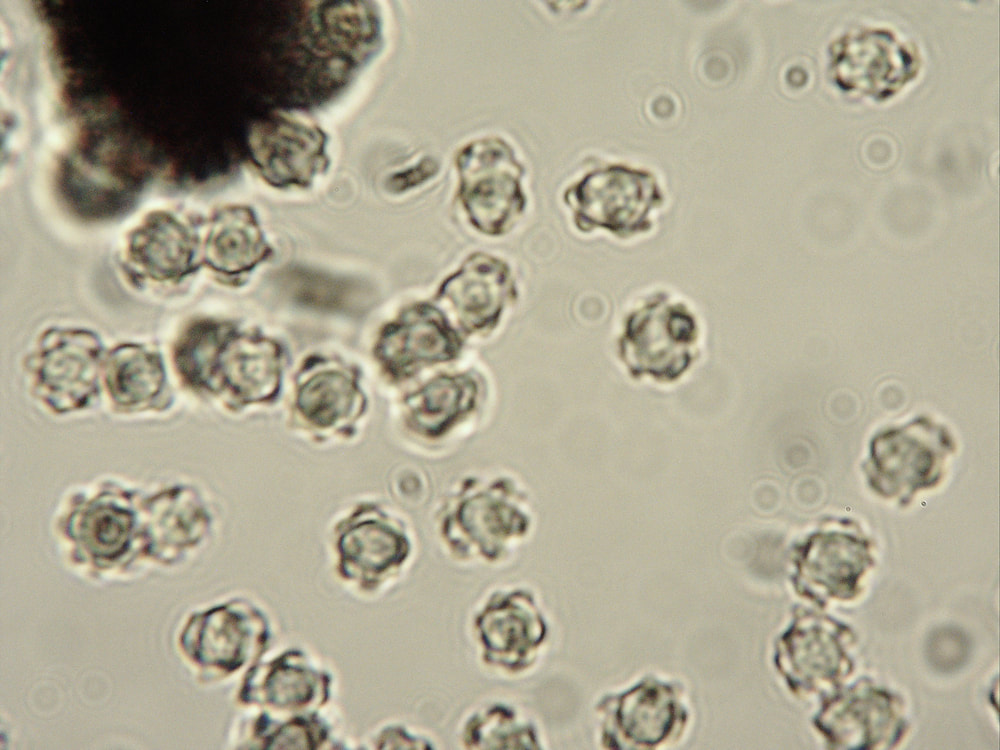Hydnellum Peckii
Hydnellum peckii is one of those bucket list mushrooms that you find when flipping through mushroom guide books. The photos of its pure white top with the droplets of bright red oozing out of it, had me hooked. 2017 was the first time I found this bizarre mushroom. I had seen it in a book and was just beginning my journey with the Willamette Valley Mushroom Society to learn about foraging. I was out hunting for Chanterelles and Boletes in the coastal range of Oregon, and walking through the dappled sunlight in the softest moss colored forest floor when I saw the bit of white peeping through the moss. I shouted for my companions to come over, and we all marvel at the way the mushroom looked like it was bleeding. I took photos and shared them with my society during the holiday potluck.
Over the years I have found them in late summer, but only in the coastal ranges of Oregon. One of the most interesting things is how they change shape and form as they grow older. The stage of "bleeding" only happens when they are young and just past pinning. As they age they become pink and brown with a velvety surface. Some of the older specimens I found this year were over 4 inches in diameter. They also tend to grow around the debris on the ground and when picked there will often be sticks and forest floor matter that has been engulfed by the mushroom.
These mushrooms are prized by dyers for the interesting colors they produce. They also, "...have found that extracts from the Bleeding Tooth Fungus contain the chemical compound atromentin, which like heparin, can be used as an anti-coagulant to keep blood clots from forming and which also has anti-bacterial properties and may be an option for treating the most common strain of bacterial pneumonia. Researchers are also looking at another chemical found in the Bleeding Tooth Fungus, thelephoric acid, which may someday be used to treat Alzheimer's disease" (bleeding-tooth-fungus).
Additionally, H. Peckii is a mycorrhizal fungi that can have up to 11 feet of mycelium connecting it to a nearby tree root. This connection offers the mushroom a source of Carbon dioxide an in turn the mycelium uses an enzyme to convert amino acids and other nutrients for the tree to readily use. These amazing fungi are a part of a forest eco system and a key player in keeping the forest thriving. Nitrogen pollution and deforestation are the biggest threats to this mushroom, and for the health of our forests and environment, we should be aware of these connections.
Additionally, H. Peckii is a mycorrhizal fungi that can have up to 11 feet of mycelium connecting it to a nearby tree root. This connection offers the mushroom a source of Carbon dioxide an in turn the mycelium uses an enzyme to convert amino acids and other nutrients for the tree to readily use. These amazing fungi are a part of a forest eco system and a key player in keeping the forest thriving. Nitrogen pollution and deforestation are the biggest threats to this mushroom, and for the health of our forests and environment, we should be aware of these connections.
Hydnellum Peckii
Classification:
Fungi
Dikarya
Basidiomycota
Agaricomycotina
Agaricomycetes
Thelephorales
Bankeraceae
Hydnellum
Description:
Cap: 2-15 cm diameter, irregular, rounded at first, them becoming convex to plane with a bit of a sunken center. White to pinkish when young with bright red droplets "bleeding" out of the cap. When older they are larger, with corse tufts in brown and pinks.
Spines: at first pinkish brown, then turning brown with age, can have red droplets when young.
Stipe: is about 2-8 cm tall, tapering and occasionally rooting, often a dark brown color.
Partial Veil: looks like a yellow skirt around the neck of the stipe
Volva: Look for sheets of universal veil remnants around the base of the stipe in rings, usually in the soil.
Flesh: tough and fibrous, often engulfing twigs and forest matter as it grows.
Spore print: brown
Spores: 5x4.5 um, globose and appearing angular and covered in irregular projections.
Odor: Earthy
Found in small groups or solitary from summer to winter under Spruce and Pine.
Classification:
Fungi
Dikarya
Basidiomycota
Agaricomycotina
Agaricomycetes
Thelephorales
Bankeraceae
Hydnellum
Description:
Cap: 2-15 cm diameter, irregular, rounded at first, them becoming convex to plane with a bit of a sunken center. White to pinkish when young with bright red droplets "bleeding" out of the cap. When older they are larger, with corse tufts in brown and pinks.
Spines: at first pinkish brown, then turning brown with age, can have red droplets when young.
Stipe: is about 2-8 cm tall, tapering and occasionally rooting, often a dark brown color.
Partial Veil: looks like a yellow skirt around the neck of the stipe
Volva: Look for sheets of universal veil remnants around the base of the stipe in rings, usually in the soil.
Flesh: tough and fibrous, often engulfing twigs and forest matter as it grows.
Spore print: brown
Spores: 5x4.5 um, globose and appearing angular and covered in irregular projections.
Odor: Earthy
Found in small groups or solitary from summer to winter under Spruce and Pine.
Resources:
Arora, David (1986). Mushrooms Demystified, 2nd ed.
https://www.mycobank.org/page/Simple%20names%20search
http://sciencenetlinks.com/blog/snl-educator/bleeding-tooth-fungus/
Siegel, Noah and Christian Schwarz (2016). Mushrooms of the Redwood Coast: A Comprehensive Guide to Fungi of Coastal Northern California
My observations:
https://www.inaturalist.org/observations/55013368
https://www.inaturalist.org/observations/55776813
https://www.inaturalist.org/observations/55013257
https://www.inaturalist.org/observations/66953802









